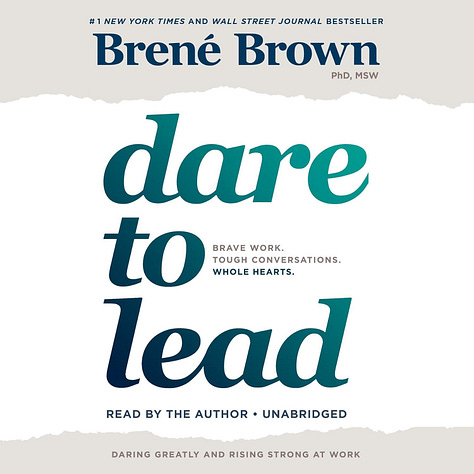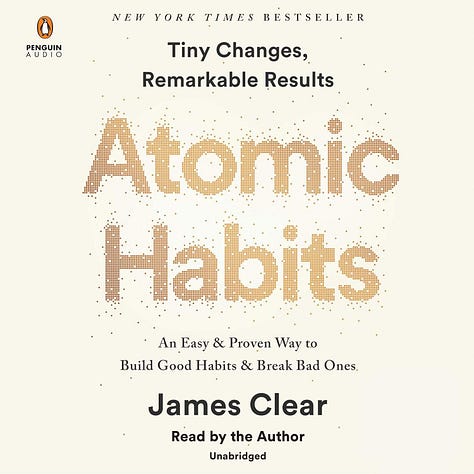Internal dialogue
A conversation about perfectionism with Anne Lamott, James Clear, and Brené Brown
If you prefer, you can listen to me read this post.
SFDs
I’ve been on a real Anne Lamott kick lately. If you haven’t read her books and you like laugh-out-loud funny and simultaneously heart wrenching prose, you oughta check her out. I’m generally suspicious when a book jacket says something is “laugh-out-loud” funny, because I rarely laugh out loud while reading. In this case, that claim is 100% true. Thanks to Anna for the author rec.
Disclaimer: As previously warned, I’m expanding my focus here on Learning, by Nature to write what I need to write. It all threads back to the existential, essential need for humans to forge emotional —heart—connections with more-than-human nature and my chosen path toward nurturing those connections through apple-a-day nature-based learning in schools (the work I do with Good Natured Learning). I’ve just let go of the need for tidy bows and straight lines.
It turns out I’ve been referencing Lamott for years by way of my former colleague – Lori Fischer – who is as brilliant a teacher as one can conjure.
Lori teaches her high school students to write “shitty first drafts.” They giggle. From there on, Lori references SFDs (her students are relatively less fond of the acronym). I’ve loved the term SFD since I first learned it because it concisely sums up a long habit of mine where I brain and gut-dump onto paper (screen), letting it all out — disorganized and crappy (pun intended) and incomprehensible and overwhelming and, especially, overwrought and then go back and try to salvage something from the words that showed up.
I didn’t connect Lamott to this term until I was listening to Brené Brown’s Dare to Lead where she leverages the idea of SFDs as the stories we tell ourselves about what’s happening that may or may not be true and cites Lamott. Lori probably gave Lamott credit as well, but I wasn’t there when she taught SFDs to her students.
I’m a decade-and-a-half late to the Brené Brown party. I first learned about Brown on a bike ride with two girlfriends several years ago and didn’t start reading her work until now. As we climbed a steep hill I mentioned something about vulnerability and one of them referenced Brené Brown’s famous Ted Talk.
“Who’s Brené Brown?” I asked.
My friend nearly fell off her bike. Like I told her I didn’t know who Taylor Swift was or had grown a unicorn horn through the air vents on my helmet.
“Oh my God, Becca. You don’t know who Brené Brown is? She’s like the middle-aged White woman’s spirit animal.”
In my defense, at the time I was blissfully pedaling away in my late thirties.
Anyhow, this isn’t really about Brené Brown, just that she’s how I found out the originator of SFDs. The coincidental piece (though Thom tells me there are no coincidences)...the timely piece was that I had just placed a hold on Lamott’s book on writing, Bird by Bird.
While reading Bird by Bird, I’m listening to James Clear’s Atomic Habits. Late to that party too.



Reading Lamott and listening to Clear on the heels of Brown is quite the combo and led to this week’s internal dialogue about perfectionism, all three in total alignment about its dangers.
Messes
It also led to a dialogue about messes, where there is some disagreement.
Specific to writing, Clear and Lamott both suggest we make writing a habit. Routine if not daily. Anne’s “short assignments” are Clear’s “2-minute habits.”
But they disagree about messes. Here’s what we discussed (in my head).
Lamott: “Why do you want everyone to be so tidy?”
Clear: “I don’t want everyone to do anything. I just want people to create a regular tidying habit if they want to identify as someone who is organized.”
Me: “James, that feels disingenuous. I mean, I know you aren’t trying to proselytize specific habits, just the having of habits, but come on. You mention cleanliness so many times I can hardly count them.”
Lamott: “Clutter is wonderfully fertile ground– you can still discover new treasures under all those piles, clean things up, edit things out, fix things, get a grip. Tidiness suggests that something is as good as it’s going to get. Tidiness makes me think of held breath, of suspended animation…” (that part is an actual quote from Bird by Bird)
Me: I’m with Anne.
<End of internal dialogue>
Perhaps because I live with a husband who is part tornado and at least one child who seems to have inherited this proclivity and perhaps because I’m not naturally that tidy either, especially because I really hate waste so I cling to bits and bobs with the idea of someday mending, repurposing, or otherwise using things, I am siding with Lamott.
It’s not unusual for Eric (my husband) to be on the verge of throwing something away – say a bottlecap or the plastic packaging from a new toothbrush – and then turn to me and say with a literal twinkle in his eye and a winking tone of voice, “but maybe you could make something with it?” It is thusly that I have bags and piles full of wine corks and scraps of fabric and old greeting cards and jar lids and plastic containers without lids that aren’t useful for storing leftovers but might be useful for something, and the soft compostable insulation that comes in Green Chef packages but isn’t really compostable unless you live in San Francisco. I’m not actually that crafty, so this is a habit built on a strong reduce-reuse-recycle identity and a mostly wistful crafty identity. My crafty friend Marty did help me sew a dog bed out of old jeans and that Green Chef packaging, so now-and-again I get there. Mostly it accumulates.
Add to my reuse-repurpose-crafty ideals the fact that I’m sentimental and I believe there’s no hope. So I’ll take this chance with Lamott to “spin” mess as a font for artistic inspiration.
I hope I can maintain that attitude rather than going on cleaning frenzies where I aggressively ask everyone in my family if they “need” various items piled on shelves in our house. Right now, as I type, I’m sitting next to Clara’s “double digit subtraction with regrouping homework” with her seed (nature!) math unit counters, a candle with stickers (it used to have poop emoji stickers adhered to it but those have been removed), an old Third Love underwear box filled with magnetic Melissa & Doug dogs with costume pieces, Nora’s unicorn puzzle (vexingly missing a piece when I literally just found them all) and its ziplock bag, a shoe-shaped pencil sharpener, my thermos, a piece of brick Clara brought back from the forest calling it her “cell phone” (!), an open Jolly phonics book turned to a page about stick insects, a Nalgene water bottle, and two pieces of plastic – origin and purpose unknown.
Arguably, this is not a conducive environment for writing. But with Lamott’s permission, I’m going to reframe and reclaim the mess.
Not in excess (Eric, if you’re reading this, do not for a minute think that this is permission to leave things out on all horizontal surfaces). One must have standards!
Still, I’m hoping this clutter can guard against perfectionism. Lamott tells it to you straight:
“Perfectionism is a mean, frozen form of idealism, while messes are the artist’s true friend. What people somehow (inadvertently, I’m sure) forgot to mention when we were children was that we need to make messes in order to find out who we are and why we are here.”
In messiness,
Becca
PS - There’s a thread back to nature-based learning and the messiness of teaching outdoors. Something about loosening your grip on control and making room for emergent, student-centered learning. I’ll take that up at some point. Just wanted to mention that the connection still exists.
PPS - As far as I can tell, the Elizabeth Street Garden is still alive and growing (see last week’s post if you’re wondering about this).



As a recovering perfectionist this all resonates (ahem) perfectly!
I have a friend who told me she was working on her perfectionism by setting the intention to be IN-efficient. I gasped. Let’s not go crazy! I would settle for just being on time instead of 5 minutes early.
My most memorable moment of mess transformation came from a school garden. A delightfully deliciously unkempt semi-wild school garden. I like to think that my sense of “tidy” evolved thanks to this garden. I began to see the beauty, the vitality, and yes the perfection in the chaos. I no longer deadhead compulsively, and allow plants (especially natives), to go to seed. I understand that some critter is banking on those seeds to feed themselves and their family.
Thank you Becca (and Anne and Brene) for making messes feel not only ok but actually desirable. 🙏🏽